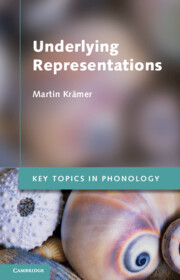Book contents
- Frontmatter
- Contents
- Acknowledgements
- Abbreviations
- 1 Getting started
- 2 Arbitrariness and opposition
- 3 Derivation and abstractness
- 4 Underspecification returns
- 5 The devil is in the detail
- 6 Psycho- and neurolinguistic evidence
- 7 On the form and contents of contrastive features
- 8 Underlying representations in Optimality Theory
- 9 Preliminary results
- Glossary
- Notes
- References
- Name index
- Language index
- Subject index
- References
3 - Derivation and abstractness
Published online by Cambridge University Press: 05 November 2012
- Frontmatter
- Contents
- Acknowledgements
- Abbreviations
- 1 Getting started
- 2 Arbitrariness and opposition
- 3 Derivation and abstractness
- 4 Underspecification returns
- 5 The devil is in the detail
- 6 Psycho- and neurolinguistic evidence
- 7 On the form and contents of contrastive features
- 8 Underlying representations in Optimality Theory
- 9 Preliminary results
- Glossary
- Notes
- References
- Name index
- Language index
- Subject index
- References
Summary
INTRODUCTION
In the development of generative phonology from structuralism the most dramatic shift in paradigm was the focus on a transformational component that turned underlying highly abstract representations into surface representations with all feature values present. As noted in the previous chapter, morphophonological alternations were built into the representations in earlier models, which caused the representations to become somewhat complex, while generalizations got lost and the distinctive features became increasingly abstract since their phonetic derivatives had to be defined in relation to phonetic context. Moreover, structuralism distinguished the lexical representation from a phonemic or archiphonemic level, the one that includes the alternation space of a phoneme, i.e., its allophones. Furthermore, the biuniqueness condition was proven to be an inappropriate condition on the relation between allophones and phonemes. It was these two theoretical assumptions, the archiphonemic level and biuniqueness, that were challenged by early generative studies and replaced by an apparatus of ordered rules that freely transform a phoneme into its contextual allophones.
The transformational component also took over some changes of a historical nature. Saussure’s strict separation of diachrony and synchrony, already criticized by Jakobson, got even more blurred. Accordingly, the machinery was used to establish underlying representations that were far removed from surface structures and linked to them by an intricate system of transformational rules. In this chapter we examine the development of this rule component and the effect these rules had on what was believed about underlying representations. These rules were basically of two types, proper phonological rules, which capture phonological alternations in morphological paradigms and which are expected to be of maximal generality, and redundancy rules, which capture static patterns, speaker intuitions on well-formedness that cannot be boiled down to proper phonological rules, and which supply feature values for predictable features or unmarked values.
- Type
- Chapter
- Information
- Underlying Representations , pp. 38 - 64Publisher: Cambridge University PressPrint publication year: 2012



